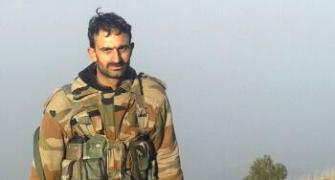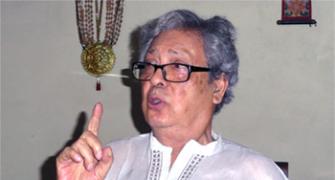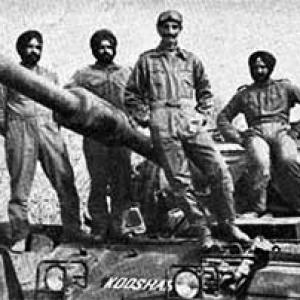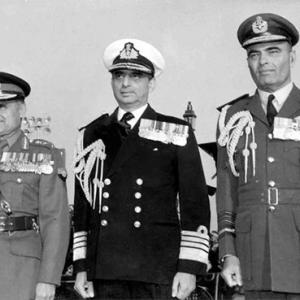'Communalism and communal riots happened in India only during and due to colonialism. Pre-colonial India didn't have this problem of communal conflicts and religious strife.'
'So far as the destruction of Nalanda University by Bakhtiyar Khilji is concerned, there is no direct evidence of it. We don't have even archaeological evidence testifying Khilji's destruction,' Mohammad Sajjad tells Syed Firdaus Ashraf/Rediff.com.

Did Bakhtiyar Khilji destroy Nalanda University?
How many Hindus converted to Islam in Bihar? What was the Muslim thinking in Bihar during Partition?
If you need answers to all these questions -- Mohammad Sajjad has published Muslim Politics in Bihar and Contesting Colonialism and Separatism: Muslims of Muzzafarpur since 1857.
An assistant professor at the Centre of Advanced Study in History, Aligarh Muslim University, he spoke to Syed Firdaus Ashraf about issues concerning Muslims pre and post Partition.
What made you write Muslim Politics in Bihar?
We did not have better known academic works on the Muslims of the 20th century (pre and post Independence) Bihar, particularly its political history.
Moreover, pertaining to the historiography of India's Partition in 1947, most of the works concentrated on Punjab, Bengal, and UP. On the issue of Partition, the Muslim League's communal territorial separatism has been explored whereas Muslim resistance to the politics of Partition remains a largely untold story.
Bihari Muslims displayed a fierce anti-colonial struggle through the Wahabbi movement during the better part of the 19th century. Subsequently, the sub-regional nationalism of Biharis emerged against the hegemony of the Bengalis on Bihar, in the forefront of which were the urban educated elites of Muslims and Kayastha Hindus.
By 1930s, they were largely replaced by the rural elites of Rajputs and Bhumihars.
Compared to UP, Bengal and other parts of India, this sub-regional nationalism of Bihar helped towards relatively lesser communal polarisation along Hindu-Muslim lines. This is how Bihar's regional political personality emerged in the colonial era.
The Muslim clergy, asserting against colonialism as well as against the communal territorial separatism of the Muslim League, was more pronounced in Bihar.
Lesser degree of communal propensity of Bihar Muslims and their resistance to the politics of Partition provided them with greater degree of confidence in post independence political participation for empowerment.
All these, and many other such aspects, tell quite new stories about Bihar which stands distinctly apart from what we have known about the rest of India and its Muslim segment.
The Bihar story asks us to revisit many of our long held stereotypical views about Muslims in the colonial and post Independence days.
You have not mentioned the destruction of Nalanda University by Bakhtiyar Khilji and how the Muslim population came and settled down in Bihar in large numbers. Why? Also can you give some background about the origins of Bihari Muslims, where are they from or were they converts from Hinduism?
My period of study in my first book, Muslim Politics in Bihar, is (set in the) 20th century and early 21st century. By way of story-telling, to establish continuity, I had to go into the 19th century only in a cursory manner.
Hence it was just beyond the scope of the book to have gone into those details pertaining to the 12th, 13th century. My specialisation is only in modern Indian history.
In my second book on Muzaffarpur, Contesting Colonialism and Separatism, which deals with the later 19th to early 21st century, I have given some details of how Islam came to the region of Tirhut in north Bihar.
In this book, the relevant section clearly narrates that most Muslims were local converts, and conversions had to do mostly with the syncretic lifestyles of the sufis.
So far as the destruction of Nalanda University by Bakhtiyar Khilji (early 13th century) is concerned, there is no direct evidence of it.
One is not sure if Khilji really did so. We don't have even archaeological evidence testifying Khilji's destruction. The university had already declined by the early 11th century as testified by Al Biruni's Kitab-ul-Hind (1030 AD).
Minhaj Siraj's Tabaqat-e-Nasiri and deriving from it Jadunath Sarkar's History of Bengal, (volume 2, pages 3-4) suggests that Bakhtiyar Khilji had attacked only the Hisar-e-Bihar (fortress of Bihar) which is modern day Biharsharif, many kilometres away from the specific site of the Nalanda university.
Even the 17th, 18th century Tibetan accounts emphasise more on Hindu (Tirthika)-Buddhist hostilities rather than on Muslim-Buddhist hostilities; and we know for sure that much earlier than the Turks, the Shunga dynasty had launched a significant assault against Buddhism.
It is quite possible that such myths about the Muslim rulers/invaders of medieval India came in circulation only in the 19th century when the colonial administrators periodised its history along communal lines whereas the British period was not characterised as Christian period.
Were the Shahabad riots of 1917 the first Hindu-Muslim riots of Bihar and of India? Can you tell us what was the reason that resulted in Hindu mobs getting incited over cow-slaughter during Bakri-Eid?
Communal riots never happen in a political vacuum. That way, the Shahabad Riots (1917) were no exception. Communalism and communal riots happened in India only during and due to colonialism.
Contrary to what C A Bayly would say in one of his essays, pre-colonial India didn't have this problem of communal conflicts and religious strife.
The anti-cow slaughter riots became recurrent in the 1880s, and it was in this decade when the Congress was founded as an organised body to contest colonialism.
There is ample evidence of landed elites and mercantile classes, the collaborators of colonialism, funding such hate-mongering agencies. Their nexus/connivance with the colonial administrators is also evident.
British Christians also consumed beef, but there was hardly any pronounced Hindu agitation against them. This in itself tells much more about the colonial politics on the issue.
Post 1857, this is significant to note that, it was only after the Champaran Satyagraha (1917) that united Hindu-Muslim assertion against the colonial State was made in Bihar linked with the ongoing national scale anti-colonial struggle, and such divisive politics of religious strife also became stronger and entrenched only around that very time.
During 1888-1917 there were many riots across north India, and in the 1920s, the Shudhi-Sangathan and Tabligh-Tanzim created unprecedented communal polarisation, and precisely, this coincides with the popular phase of the Indian national movement.
Post the 1857 rebellion, when did the first Hindu-Muslim riot occur in India? What was the reason and what were the lasting consequences?
If you are referring to my second book (Muzaffarpur, Contesting Colonialism and Separatism), then my exploration says that it was in 1895. In the village of Mathurapur near Sheohar, that first recorded Hindu-Muslim violence took place around the issue of cow slaughter.
Earlier in 1892-1893, as explored by Anand Yang, a major riot broke out in Basantpur (Siwan), where the social and economic network of weekly haats (market) were used as an agency of communication to plan and execute the riots.
You mention that Gandhi insisted on preventing cow slaughter, but also advised the Hindus to pay the Muslims twice the value of their losses, with the help of Hindus from all over India if necessary. What is the source of the information?
The source of information is the biographical account of Mazharul Haque (1866-1930) written by Qeyamuddin Ahmad and Jata Shankar Jha which was published by the publication division of the Government of India in 1970.
The authors have cited primary evidences. The multi volume Collected Works of Mahatma Gandhi have also got such evidences, the reference to which somehow stand omitted in the footnote. It may have happened at the final stage of publication.
How far is it true that before the Partition of India, the Muslims of Bihar feared that if cow slaughter was banned then in the future a Hindu majority  government would also ban the calling of Azan in mosques?
government would also ban the calling of Azan in mosques?
This kind of fear-mongering could have been generated by forces like the Muslim League, but such issues would have got credence only after 1938 when the Congress ministry was not adequately forthcoming in re-assuring and taking necessary administrative steps against the hate-mongers.
Image: Mohammad Sajjad teaches at the Aligarh Muslim University.
Moreover, there are ample evidences of provincial and district units of the Congress having majoritarian communal orientations and it often overlapped with the Hindu Mahasabha kind of organisations.
The colonial State played its own roles. However this should also be underlined that at the top level of the Congress no resolution could ever be passed which could create any such misgivings among the minorities.
What was the reason that the Muslim League in December 1919 gave a call to give up cow sacrifice on Baqri-Eid?
This needs to be understood and emphasised that the Bihar Muslim League clearly had a distinct character from that of the All India Muslim League because of the fact that the early leadership of the League, who were also with the Congress, had pluralistic convictions, and as said earlier, the political evolution of Muslims in Bihar had traversed a trajectory whereby inter-community cooperation and harmony was the hallmark.
They were very clear about the fact that without Hindu-Muslim unity, driving out the colonial masters was a difficult proposition. This is also testified by the fact that Bihar could hardly throw a leader of big stature for the Muslim League.
The few leaders of the Muslim League in Bihar, having hardly any significance beyond Bihar, like Syed Abdul Aziz (1885-1948), Syed Jafar Imam (1901-1979), Syed Badruddin Ahmad (1901-1983), were those who did not support the idea of migration in 1947.
In fact, by March-May 1947, the Bihar Muslim League, in its various meetings in Gaya, Patna, and Kishanganj adopted resolutions to provincial partitioning along religious lines, rather than endorsing the idea of the creation of a separate sovereign State.
And even that idea of provincial partitioning was in the face of rioting and bloodshed.
Why did the Moplah riots of Kerala affect Hindu-Muslim relations in Bihar? Bihar, after all, is hundreds of miles away from Kerala, but still the Moplah riots affected Bihar badly in 1921. Why?
After the Non-Cooperation-Khilafat Movement (1920-1922), communal polarisation increased in an unprecedented manner. It is difficult to ascertain that it was solely because of the communal riots of the Malabar coast (more informed researches reveal that it was more an agrarian tension than a religious strife).
The communal conflicts should rather be tried to be understood in terms of assertions for power-sharing. With the Act of 1919, and its previous incarnations, the scrambles for power-sharing increased manifold, and the colonial set up of identity-based representations, perpetuated through the tool of census along those lines, had already unleashed identity-based mobilisations which were the ways of being recognised for representations in the evolving structures and processes of power.
On page 108 of your book you mention that Rajendra Prasad, later India's first President, was involved in the Shuddhi movement (bringing Muslims back into the Hindu fold). This seems an unbelievable assertion. Can you elaborate on this fact?
You are referring to my book, Muslim Politics in Bihar. Please also refer to my book, Contesting Colonialism and Separatism (page 96). Dr Rajendra Prasad was among the founders of the Bihar Hindu Sabha (founded in 1907 and revived in 1911), and at least till 1926, Rajendra Prasad was on the executive committee of the All India Hindu Mahasabha.
He was also the chairman of the reception committee of the Gaya session of the Hindu Mahasabha in 1923 where he had persuaded Madan Mohan Malaviya (1866-1946) to preside over the session.
In August 1923, at Benaras, the Hindu Mahasabha resolved to go for a Shuddhi programme and to raise squads for Hindu self-defence. Rajendra Prasad's autobiography (page 182) gives all these details.
What was the reason for Dr Rajendra Prasad not allowing Dr Syed Mahmud to become chief minister of Bihar in the provincial autonomy government?
It is rather puzzling that Rajendra Prasad does not elaborate much upon it. Maulana Azad, in his India Wins Freedom (page 16-17) does express his indignation unambiguously at neglecting Syed Mahmud -- the tallest one in terms of stature in the Bihar Congress, excepting Prasad himself who was evidently not interested in becoming Bihar premier -- and in his stead propping up Shri Krishna Sinha (1887-1961), a Bhumihar, and Anugraha Narayan Sinha (1887-1957), a Rajput, who were then in the Central Assembly, and not in the provincial assembly.
Yet, quite interestingly, in fact misleadingly, Rajendra Prasad, in his autobiography (page 438) rather records that Maulana Azad was quite satisfied with Prasad's decision.
Main Image: Kadamdeen, a 70 year old who was displaced in the Muzaffarnagar riots last year. Photographer: Anindito Mukherjee/Reuters










